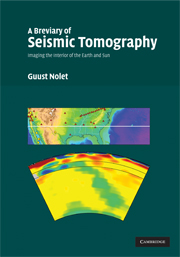Book contents
- Frontmatter
- Contents
- Preface
- 1 Introduction
- 2 Ray theory for seismic waves
- 3 Ray tracing
- 4 Wave scattering
- 5 Body wave amplitudes: theory
- 6 Travel times: observations
- 7 Travel times: interpretation
- 8 Body wave amplitudes: observation and interpretation
- 9 Normal modes
- 10 Surface wave interpretation: ray theory
- 11 Surface waves: finite-frequency theory
- 12 Model parametrization
- 13 Common corrections
- 14 Linear inversion
- 15 Resolution and error analysis
- 16 Anisotropy
- 17 Future directions
- References
- Author index
- General index
3 - Ray tracing
Published online by Cambridge University Press: 24 January 2011
- Frontmatter
- Contents
- Preface
- 1 Introduction
- 2 Ray theory for seismic waves
- 3 Ray tracing
- 4 Wave scattering
- 5 Body wave amplitudes: theory
- 6 Travel times: observations
- 7 Travel times: interpretation
- 8 Body wave amplitudes: observation and interpretation
- 9 Normal modes
- 10 Surface wave interpretation: ray theory
- 11 Surface waves: finite-frequency theory
- 12 Model parametrization
- 13 Common corrections
- 14 Linear inversion
- 15 Resolution and error analysis
- 16 Anisotropy
- 17 Future directions
- References
- Author index
- General index
Summary
To find the correct geometry of a ray in realistic models of the Earth or Sun, we need to solve (2.27) numerically. This is comparatively easy in the case of layered or spherically symmetric media. On the other hand, if the seismic velocity is also a function of one or two horizontal coordinates, it may be very difficult. Fortunately, Fermat's Principle often allows us to use background models with lateral homogeneity, as I discussed in Section 2.9. In extreme cases, however, the seismic velocities may change sufficiently fast that the ray computed for a layered Earth is too far away from the ray in the true, heterogeneous Earth. In that case we must use full 3D ray tracing. In this chapter we take a look at the most promising algorithms available for both cases but warn the reader that accurate ray tracing in 3D is still an active area of research that has not yet converged to one ‘ideal’ method. In fact all methods still have shortcomings.
The shooting method
To find the correct ray geometry between a given source and receiver location we not only need an accurate solver for the differential equations such as (2.34) and (2.32), but also a way to determine which initial condition (ray orientation at the source) satisfies the end condition (ray arriving in the receiver).
- Type
- Chapter
- Information
- A Breviary of Seismic TomographyImaging the Interior of the Earth and Sun, pp. 40 - 57Publisher: Cambridge University PressPrint publication year: 2008



